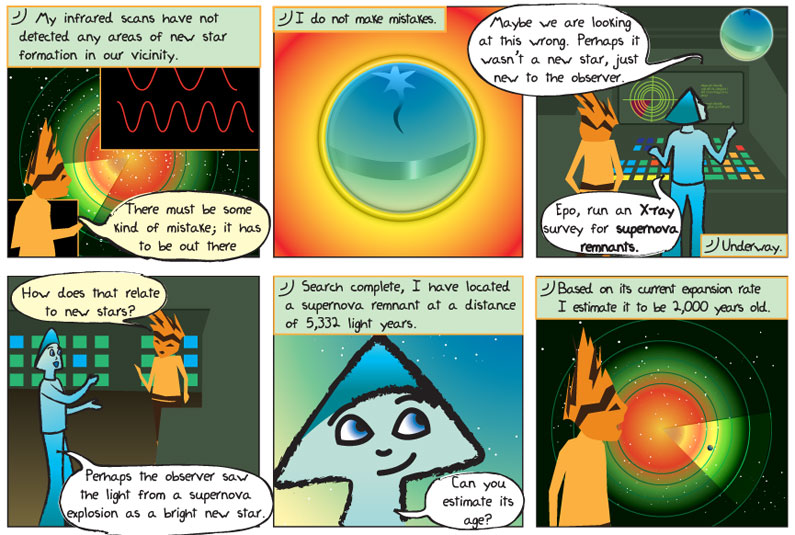
Transcript:
Panel 1
Epo: My infrared scans have not detected any areas of new star formation in our vicinity.
Beggrin: There must be some kind of mistake; it has to be out there.
Panel 2
Epo: I do not make mistakes.
Panel 3
Alkina: Perhaps we are looking at this wrong. Perhaps it wasn’t a new star, just new to the observer. Epo, run an X-ray survey for supernova remnants.
Panel 4
Beggrin: How does that relate to new stars?
Alkina: Perhaps the observer saw the light from a supernova explosion as a bright new star.
Panel 5
Epo: Search complete, I have located a supernova remnant at a distance of 5,332 light years.
Alkina: Can you estimate it’s age?9+6
Panel 6
Epo: Based on its current expansion rate I estimate it to be two thousand years old.
What does it mean?
Supernova – The explosion of a star near the end of its lifetime, as it runs out of nuclear fuel in its core. Only massive stars can become supernovae. Supernova explosions are so bright they can be easily observed in other galaxies.
Supernova Remnant – The expanding cloud of gas and dust pushed out from a star by a supernova. These travel at very high speeds and can be hot enough to emit X-rays.
X-ray – high energy electromagnetic radiation that is more powerful than visible and ultra-violet light but less energetic than gamma-rays. Because of their high energies and short wavelengths, x-rays can easily pass through “soft” materials and can be used to image the insides of things, like the human body.
In human speak please!
Supernovae explosions happen when massive stars reach the end of their lives and undergo a gravitational core collapse that causes them to eject their outer layers violently, leaving behind a very dense neutron star. This explosion often leaves behind a rapidly expanding shell of material from the star, which impacts with the gas and dust around the star, and can be hot enough to generate X-rays. This expanding shell is known as the supernova remnant, and it can expand at rates of thousands of kilometers per second. Eventually, the shock waves will be dissipated, leaving behind some of the heavier elements that were created in the star.
The word “nova” comes from the Latin word “novus” which means “new;” early astronomers thought that supernovae signaled the birth of a new star, not the death of an exhausted one. The most studied supernova remnant is the Crab Nebula. Light from the supernova that created the Crab Nebula first reached Earth in the year 1054. The event was recorded by Chinese, Japanese, Arab, and Native American observers. The light from the supernova was bright enough to be seen in full daylight for 23 days and visible in the night sky for 653 days before finally fading from sight. At its peak, the supernova may have been as bright as the full moon. Today the Crab Nebula is still one of the easiest and most exciting objects to view with a small telescope.
